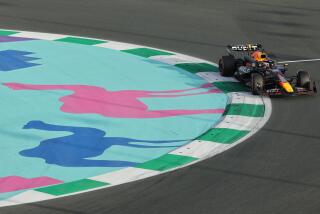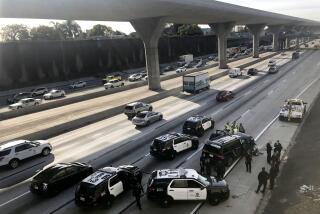Racing Radio-Controlled Cars in the Dirt Can Be Model Pastime
Between classes at Oakwood, a private school in North Hollywood, a stream of boys stopped at a 12-year-old’s locker to admire the colorful images he had attached in a cluttered display to the inside of the narrow metal door. Each boy commented: “I have one of those” or “I’m getting one like that.”
The objects of these junior high school students’ interest are radio-controlled model cars--the central icons of one of the San Fernando Valley’s fastest-growing hobbies.
In the past year, off-road racing of these miniature automobiles has caught on in a big way. Hobbyists from 5 to 80 are seeking out model shops, many to buy their first car kit on relatively limited budgets. Thoroughly hooked enthusiasts return again and again to modify and upgrade engines and parts, to replace one car with another or to augment a growing collection of vehicles for different types of racing.
Friday nights, from 7 to midnight, about 90 model-car owners can be found at the Valley’s only off-road track, Race Prep Raceway on Victory Boulevard in Encino.
On a recent Friday, the curvy, steeply banked dirt track, operated by a hobby shop in Canoga Park, was lightly hosed in preparation for the evening’s races. On the scoring tower, a personal computer kept track of what race was up, each individual’s lap time and the position in which each car finished. Someone punched in the number of each car as it passed the tower. Cars whizzed by as fast as 35 m.p.h.
Maryann Sittman of Northridge bought her first car a month ago after watching her husband race his car for two years. They go to several races a month, at this and other tracks around the Southland. She said she found the races boring until she learned enough about the cars to help her husband.
“I’ve been his pit crew for two years,” she said. “It’s time for him to be mine now. This is basically the first technical thing I’ve done.”
Her husband, J.R., the owner of a computer repair company, got interested in racing when he helped a friend put together a car. As soon as he tried it in a parking lot, he was hooked. “Right now I’m in the top 15 out of 135 people in both my classes,” Sittman said. “It’s our only hobby.”
Model-car racing fills the hobby needs of many people who have tried other recreations.
“My brother and I were looking for a hobby, a way to get away from the idiot box,” said Steven Ross, 33, of Van Nuys. “I like the mechanical end of it best.”
Having spent thousands of dollars on racing sand dragsters several years ago, Ross finds model-car racing more appropriate for a family man. “Oh, I’m sure I’ll get bored with it soon,” he said. “But what’s good is that you can take the dog, the wife and the kid to the park. You see whole families lying out on chaise lounges, Dad tinkering with his car, the kid tinkering with his.”
His younger brother, Mark, finds the competitiveness most exciting. He also likes the fact that, unlike racers of big cars, you cannot simply out-buy the competition. “It gets down to a few little tricks and driving skill,” he said. He plans to race his new car when he feels more confident. “Now, I’d make a fool of myself,” he said.
Technical Aptitude
The cars, which come in kits, are about 15 inches long. A degree of technical aptitude is required to put one together. Perhaps that is why a disproportionate number of drivers, or their fathers, work at technical professions, along with everything “from garbage collectors to retired millionaires,” in the words of one veteran driver.
It can be a costly hobby. When radio-controlled cars collide or do dramatic flips off a dirt jump, the damage is usually minimal. Still, the repair process is ongoing and can be expensive.
When Robert Sunseri started racing a few years ago--off-road racing arrived from Japan only five years ago--he raced at baseball diamonds and in the street. He says he spent $2,000, which includes a number of improvements, putting his car back together the first year.
“It’s not only the drive,” he said. “I didn’t start taking first, second, and third place until I changed cars. It’s important to be knowledgeable about cars and parts and see who’s winning the races with what cars.”
Weekday Practice
That lesson has already been learned by Kevin Lakkis, 12, of Los Angeles, who bought his first car two months ago and hasn’t raced competitively. Since Race Prep’s track is open, though not maintained, during the week, Kevin practices there occasionally after school.
He needed to fix something minor nearly every time he drove his car the first week or two. He has replaced worn-out tires, installed a more powerful motor and needs a second battery. The cars run 10 to 15 minutes per charge and take 15 minutes to recharge.
“I’ve wanted a car like this since I was 6 and saw one in a toy store,” he said, adding that he will probably buy a faster, more expensive car soon.
The expense of radio-controlled car racing varies considerably. The casual hobbyist can get by with an initial investment of a few hundred dollars and perhaps $15 to $20 dollars each race, which includes repairs and Race Prep Raceway’s $6 entry fee. Watching is free.
‘Wads of Money’
These figures may have slowed them down, but they haven’t deterred a large number of Valley boys.
“I see kids come into hobby shops with wads of money,” said Steven Ross. Ross, the car department manager at MK Model Products in North Hollywood, said most youngsters start at about age 10 or 12.
“It’s expensive, but I don’t mind paying for it because I know where they are, I know what they’re doing, and they’re very happy with it,” said Ziegfried Beier, a Chatsworth machinist with sons 12 and 16 years old.
“Eric works on his car in the garage until midnight,” Beier said. “My wife likes it, too, because he gets so involved he puts everything he has into it.”






